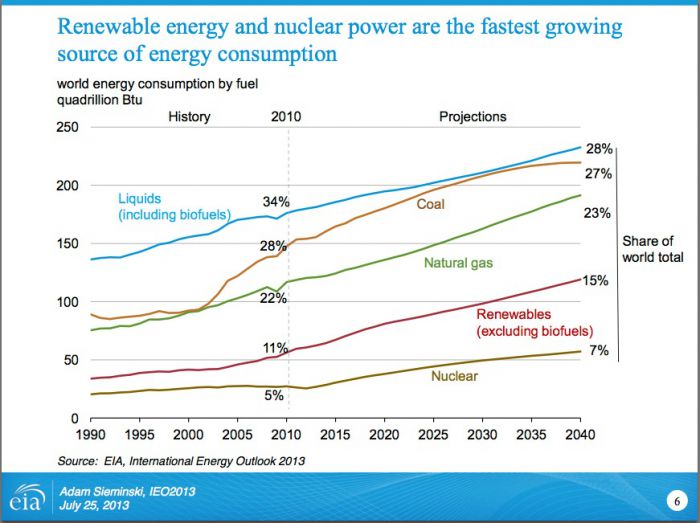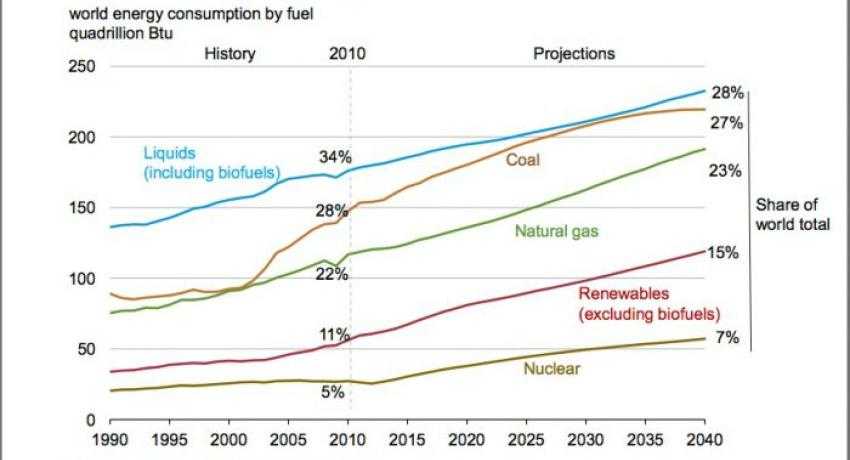By 2040 energy use to rise by 56 percent across world
 Between now and 2040 the U.S. Energy Information Administration (EIA) anticipates that the use of energy throughout the world will by 56 percent. That’s the take from its International Energy Outlook 2013, which was released today, July 25. While the report found that use of renewable energy will rise by 2.5 percent every year, the dominant energy source is anticipated to be natural gas.
Between now and 2040 the U.S. Energy Information Administration (EIA) anticipates that the use of energy throughout the world will by 56 percent. That’s the take from its International Energy Outlook 2013, which was released today, July 25. While the report found that use of renewable energy will rise by 2.5 percent every year, the dominant energy source is anticipated to be natural gas.
Overall the outlook anticipated that energy demand will grow to 820 quadrillion British thermal units (Btus) in 2040. In 2010 humans across the world consumed 524 quadrillion BTus. "Rising prosperity in China and India is a major factor in the outlook for global energy demand,” said EIA Administrator Adam Sieminski. “These two countries combined account for half the world's total increase in energy use through 2040." He added that it will have a profound effect on how world energy markets develop.
The report anticipated that clean energy (including nuclear) is expected to grow faster than the use of fossil fuels. “Renewable energy and nuclear power are the world's fastest-growing energy sources, each increasing by 2.5 percent per year,” according to the report. “However, fossil fuels continue to supply almost 80 percent of world energy use through 2040.”
Of the renewable energy, 80 percent, of new renewable electricity generation will come from hydropower and wind power, the report found. “The contribution of wind energy, in particular, has grown rapidly over the past decade, from 18 gigawatts of net installed capacity at the end of 2000 to 183 gigawatts at the end of 2010—a trend that continues into the future,” it said. It attributes 1.5 trillion new kilowatt hours to wind and 2.8 trillion kilowatts hours to hydroelectric power.
Solar will account for some but not all of the remaining new renewable energy that comes on over the next three decades. But it still faces some issues. “High construction costs can make the total cost of building and operating renewable generators higher than those for conventional plants. The intermittence of wind and solar energy, in particular, can further hinder the economic competitiveness of those resources, as they are not necessarily available when they would be of greatest value to the system,” the report stated. It contended that improvements in battery storage technology and the ability to disperse wind and solar over wide geographic areas can help mitigate some of the intermittency issues.
Meanwhile the EIA report anticipates that the use of fossil fuels will go up with natural gas leading the way. While natural gas is anticipated to grow by 1.7 percent per year, that’s below renewable energy’s anticipated growth. Although liquid fuels will still be among the biggest sources of energy—likely largely because of transportation, they’re share of the world’s energy consumption will fall from 34 percent in 2010 to 28 percent in 2040.




